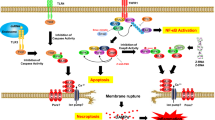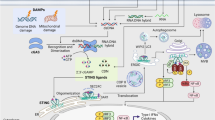Abstract
Opuntia ficus indica(prickly pear) polyphenolic compounds (OFPC) triggered an increase in [Ca2+]i in human Jurkat T-cell lines. Furthermore, OFPC-induced rise in [Ca2+]i was significantly curtailed in calcium-free buffer (0% Ca2+) as compared to that in 100% Ca2+ medium. Preincubation of cells with tyrphostin A9, an inhibitor of Ca2+ release-activated Ca2+(CRAC) channels, significantly diminished the OFPC-induced sustained response on the increases in [Ca2+]i. Lanthanum and nifedipine, the respective inhibitors of voltage-dependent and L-type calcium channels, failed to curtail significantly the OFPC-induced calcium response. As OFPC still stimulated increases in [Ca2+]i in 0% Ca2+ medium, the role of intracellular calcium was investigated. Hence, addition of thapsigargin (TG), an inhibitor of Ca2+-ATPase of the endoplasmic reticulum (ER), during the OFPC-induced peak response exerted an additive effect, indicating that the mechanism of action of these two agents are different. Furthermore, U73122, an inhibitor of IP3 production, completely abolished increases in [Ca2+]i, induced by OFPC, suggesting that these polyphenols induce the production of IP3 that recruits calcium from ER pool. Polyphenolic compounds do act extracellularly as addition of fatty acid-free bovine serum albumin (BSA) significantly diminished the rise in [Ca2+]i evoked by the formers. OFPC also induced plasma membrane hyperpolarisation which was reversed by addition of BSA. OFPC were found to curtail the expression of IL-2 mRNA and T-cell blastogenesis. Together these results suggest that OFPC induce increases in [Ca2+]i via ER pool and opening of CRAC channels, and exert immunosuppressive effects in Jurkat T-cells.
Similar content being viewed by others
References
Rodriguez-Felix A, Cantwell M: Developmental changes in composition and quality of prickly pear cactus cladodes (nopalitos). Plant Foods Hum Nutr 38: 83-93, 1988
Galati EM, Tripodo MM, Trovato A, Miceli N, Monforte MT: Biological effect of Opuntia ficus indica (L.) Mill. (Cactaceae) waste matter. Note I: diuretic activity. J Ethnopharmacol 79: 17-21, 2002
El Kossori RL, Villaume C, El Boustani E, Sauvaire Y, Mejean L: Composition of pulp, skin and seeds of prickly pears fruit (Opuntia ficus indica sp.). Plant Foods Hum Nutr 52: 263-270, 1998
Butera D, Tesoriere L, Di Gaudio F, Bongiorno A, Allegra M, Pintaudi AM, Kohen R, Livrea MA: Antioxidant activities of Sicilian prickly pear (Opuntia ficus indica) fruit extracts and reducing properties of its betalains: Betanin and indicaxanthin. J Agric Food Chem 50: 6895-6901, 2002
Frati AC, Jimenez E, Ariza CR, Hypoglycemic effect of Opuntia ficus indica in non insulin-dependent diabetes mellitus patients. Phytother Res 4: 195-197, 1990
Hegwood DA: Human healthy discoveries with Opuntia sp. (prickly pear). Hort Sci 25: 1515-1516, 1990
Fernandez ML, Lin EC, Trejo A, McNamara DJ: Prickly pear (Opuntia sp.) pectin reverses low density lipoprotein receptor suppression induced by a hypercholesterolemic diet in guinea pigs. J Nutr 122: 2330-2340, 1992
Bwititi PT, Machakaire T, Nhachi CB, Musabayane CT: Effects of Opuntia megacantha leaves extract on renal electrolyte and fluid handling in streptozotocin (STZ)-diabetic rats. Ren Fail 23: 149-158, 2001
Fernandez ML, Lin EC, Trejo A, McNamara DJ: Prickly pear (Opuntia sp.) pectin alters hepatic cholesterol metabolism without affecting cholesterol absorption in guinea pigs fed a hypercholesterolemic diet. J Nutr 124: 817-824, 1994
Wolfram RM, Kritz H, Efthimiou Y, Stomatopoulos J, Sinzinger H: Effect of prickly pear (Opuntia robusta) on glucose-and lipid-metabolism in non-diabetics with hyperlipidemia — a pilot study. Wien Klin Wochenschr 114: 840-846, 2002
Budinsky A, Wolfram R, Oguogho A, Efthimiou Y, Stamatopoulos Y, Sinzinger HH: Regular ingestion of Opuntia robusta lowers oxidation injury. Prostagland Leukot Essent Fatty Acids 65: 45-50, 2001
Benkhalti F, Prost J, Paz E, Perez-Jimenez F, El Modafar C, El Boustani E: Effects of feeding virgin olive oil or their polyphenols on lipid of rat liver. Nutr Res 22: 1067-1075, 2002
Carbo N, Costelli P, Baccino FM, Lopez-Soriano FJ, Argiles JM: Resveratrol, a natural product present in wine, decreases tumour growth in a rat tumour model. Biochem Biophys Res Commun 254: 739-743, 1999
Tapiero H, Tew KD, Ba GN, Mathe G: Polyphenols: Do they play a role in the prevention of human pathologies? Biomed Pharmacother 56: 200-207, 2002
Bravo L: Polyphenols: Chemistry, dietary sources, metabolism, and nutritional significance. Nutr Rev 56: 317-333, 1998
Wiseman SA, Balentine DA, Frei B: Antioxidants in tea. Crit Rev Food Sci Nutr 37: 705-718, 1997
Leenen R, Roodenburg AJ, Tijburg LB, Wiseman SA: A single dose of tea with or without milk increases plasma antioxidant activity in humans. Eur J Clin Nutr 54: 87-92, 2000
Martinez J, Moreno JJ: Effect of resveratrol, a natural polyphenolic compound, on reactive oxygen species and prostaglandin production. Biochem Pharmacol 59: 865-870, 2000
Ahmad N, Cheng P, Mukhtar HH: Cell cycle dysregulation by green tea polyphenol epigallocatechin-3-gallate. Biochem Biophys Res Commun 275: 328-334, 2000
Ren F, Zhang S, Mitchell SH, Butler R, Young CY: Tea polyphenols down-regulate the expression of the androgen receptor in LNCaP prostate cancer cells. Oncogene 19: 1924-1932, 2000
Liang YC, Lin-shiau SY, Chen CF, Lin JK: Suppression of extracellular signals and cell proliferation through EGF receptor binding by (−)-epigallocatechin gallate in human A431 epidermoid carcinoma cells. J Cell Biochem 67: 55-65, 1997
Kennedy DO, Nishimura S, Hasuma T, Yano Y, Otani S, Matsui-Yuasa I: Involvement of protein tyrosine phosphorylation in the effect of green tea polyphenols on Ehrlich ascites tumor cells in vitro. Chem Biol Interact 110: 159-172, 1998
Cantrell DA: T cell antigen receptor signal transduction pathways. Cancer Surv 27: 165-175, 1996
Crabtree GR: Generic signals and specific outcomes: Signaling through Ca2+, calcineurin, and NF-AT. Cell 96: 611-614, 1999
Crabtree GR: Calcium, calcincurin, and the control of transcription. J Biol Chem 276: 2313-2316, 2001
Kremer JM, Lawrence DA, Jubiz W, DiGiacomo R, Rynes R, Bartholomew LE, Sherman M: Dietary fish oil and olive oil supplementation in patients with rheumatoid arthritis. Clinical and immunologic effects. Arth Rheum 33: 810-820, 1990
Bittiner SB, Tucker WF, Cartwright I, Bleehen SS: A double-blind, randomised, placebo-controlled trial of fish oil in psoriasis. Lancet 1: 378-380, 1988
Notkins AL, Lernmark AA: Autoimmune type 1 diabetes: Resolved and unresolved issues. J Clin Invest 108: 1247-1252, 2001
Bjorneboe A, Soyland E, Bjorneboe GE, Rajka G, Drevon CA: Effect of dietary supplementation with eicosapentaenoic acid in the treatment of atopic dermatitis. Br J Dermatol 117: 463-469, 1987
Ma A, Datta M, Margosian E, Chen J, Horak I: T cells, but not B cells, are required for bowel inflammation in interleukin 2-deficient mice. J Exp Med 182: 1567-1572, 1995
Li HC, Yashiki S, Sonoda J, Lou H, Ghosh SK, Byrnes JJ, Lema C, Fujiyoshi T, Karasuyama M, Sonoda S: Green tea polyphenols induce apoptosis in vitro in peripheral blood T lymphocytes of adult T-cell leukemia patients. Jpn J Cancer Res 91: 34-40, 2000
Tomita M, Irwin KI, Xie ZJ, Santoro TJ: Tea pigments inhibit the production of type 1 (T-H1) and type 2 (T-H2) helper T cell cytokines in CD4(+) T cells. Phytother Res 16: 36-42, 2002
Rink TJ, Montecucco C, Hesketh TR, Tsien RY: Lymphocyte membrane potential assessed with fluorescent probes. Biochim Biophys Acta 595: 15-30, 1980
Tessier C, Hichami A, Khan NA: Implication of three isoforms of PLA2 in human T-cell proliferation. FEBS Lett 520: 111-116, 2002
Marhaba R, Mary F, Pelassy C, Stanescu AT, Aussel C, Breittmayer JP: Tyrphostin A9 inhibits calcium release-dependent phosphorylations and calcium entry via calcium release-activated channel in Jurkat T cells. J Immunol 157: 1468-1473, 1996
Tsein RW: Calcium channels in excitable cell membranes. Annu Rev Physiol 45: 341-358, 1983
Thastrup O, Cullen PJ, Drobak BK, Hanley MR, Dawson AP: Thapsigargin, a tumor promoter, discharges intracellular Ca2+ stores by specific inhibition of the endoplasmic reticulum Ca2(+)-ATPase. Proc Natl Acad Sci USA 87: 2466-2470, 1990
Zweifach A, Lewis RS: Mitogen-regulated Ca2+ current of T lymphocytes is activated by depletion of intracellular Ca2+ stores. Proc Natl Acad Sci USA 90: 6295-6299, 1993
Lewis RS, Cahalan MD: Potassium and calcium channels in lymphocytes. Annu Rev Immunol 13: 623-653, 1995
Premack BA, McDonald TV, Gardner PP: Activation of Ca2+ current in Jurkat T cells following the depletion of Ca2+ stores by microsomal Ca(2+)-ATPase inhibitors. J Immunol 152: 5226-5240, 1994
Martin S, Andriambeloson E, Takeda K, Andriantsitohaina RR: Red wine polyphenols increase calcium in bovine aortic endothelial cells: A basis to elucidate signalling pathways leading to nitric oxide production. Br J Pharmacol 135: 1579-1587, 2002
Conforti L, Petrovic M, Mohammad D, Lee S, Ma Q, Barone S, Filipovich AH: Hypoxia regulates expression and activity of kv1.3 channels in T lymphocytes: A possible role in T cell proliferation. J Immunol 170: 695-702, 2003
Putney JW JR: Type 3 inositol 1,4,5-trisphosphate receptor and capacitative calcium entry. Cell Calcium 21: 257-261, 1997
Benoit C, Renaudon B, Salvail D, Rousseau EE: EETs relax airway smooth muscle via an EpDHF effect: BK(Ca) channel activation and hyperpolarization. Am J Physiol Lung Cell Mol Physiol 280: L965-L973, 2001
Donnadicu E, Bismuth G, Trautmann A: Calcium fluxes in T-lymphocytes. J Biol Chem 267: 25864-25872, 1992
Negulescu PA, Shastri N, Cahalan MD: Intracellular calcium dependence of gene expression in single T lymphocytes. Proc Natl Acad Sci USA 91: 2873-2877, 1994
Dolmetsch RE, Lewis RS, Goodnow CC, Healy JI: Differential activation of transcription factors induced by Ca2+ response amplitude and duration. Nature 386: 855-858, 1997
Berry N, Ase K, Kikkawa U, Kishimoto A, Nishizuka YY: Human T cell activation by phorbol esters and diacylglycerol analogues. J Immunol 143: 1407-1413, 1989
Sanbongi C, Suzuki N, Sakane T: Polyphenols in chocolate, which have antioxidant activity, modulate immune functions in humans in vitro. Cell Immunol 177: 129-136, 1997
Atluru D, Jackson TM, Atluru S: Genistein, a selective protein tyrosine kinase inhibitor, inhibits interleukin-2 and leukotriene B4 production from human mononuclear cells. Clin Immunol Immunopathol 59: 379-387, 1991
Devi MA, Das NP: In vitro effects of natural plant polyphenols on the proliferation of normal and abnormal human lymphocytes and their secretions of interleukin-2. Cancer Lett 69: 191-196, 1993
Author information
Authors and Affiliations
Rights and permissions
About this article
Cite this article
Aires, V., Adote, S., Hirchami, A. et al. Modulation of intracellular calcium concentrations and T cell activation by prickly pear polyphenols. Mol Cell Biochem 260, 103–110 (2004). https://doi.org/10.1023/B:MCBI.0000026061.57326.28
Issue Date:
DOI: https://doi.org/10.1023/B:MCBI.0000026061.57326.28




